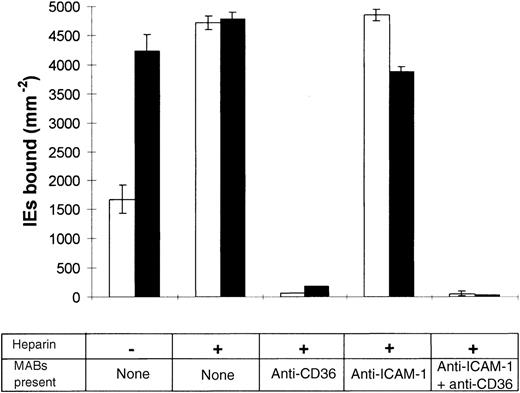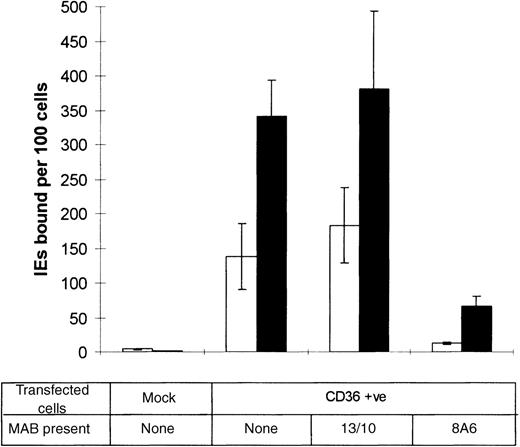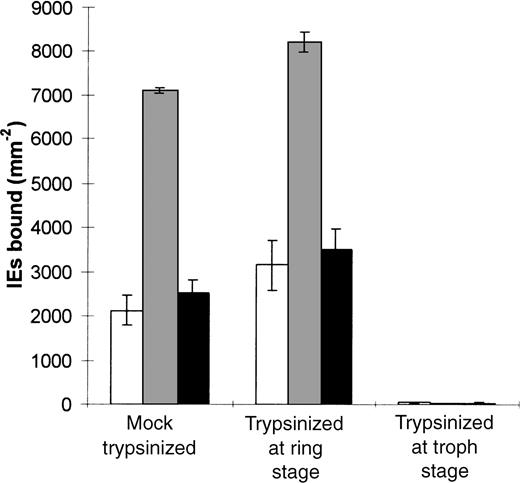Abstract
A novel adhesive pathway that enhances the adhesion ofPlasmodium falciparum-infected erythrocytes (IEs) to endothelial cells has been identified. The sulfated glycoconjugates heparin, fucoidan, dextran sulfate 5000, and dextran sulfate 500 000 caused a dramatic increase in adhesion of IEs to human dermal microvascular endothelial cells. The same sulfated glycoconjugates had little effect on IE adhesion to human umbilical vein endothelial cells, a CD36-negative cell line. The effect was abolished by a monoclonal antibody directed against CD36, suggesting that enhanced adhesion to endothelium is dependent on CD36. No effect was observed on adhesion to purified platelet CD36 cells immobilized on plastic. The same sulfated glycoconjugates enhanced adhesion of infected erythrocytes to COS cells transfected with CD36, and this was inhibited by the CD36 monoclonal antibody. These findings demonstrate a role for sulfated glycoconjugates in endothelial adherence that may be important in determining the location and magnitude of sequestration through endogenous carbohydrates. In addition, they highlight possible difficulties that may be encountered from the proposed use of sulfated glycoconjugates as antiadhesive agents in patients with severe malaria.
Intercellular adhesive interactions are critical events in the pathogenesis of infection and the host response to it. In malaria due to Plasmodium falciparum, the infected erythrocytes (IEs) adhere both to endothelial cells1,2 and, in a strain-specific manner, to uninfected red blood cells (RBCs), thereby leading to the formation of rosettes.3 Adhesion to endothelium is thought to be a critical factor in the pathogenesis of disease,4,5 and rosetting, which may contribute to vascular plugging, has been associated with severe malaria.6 7
The adhesive properties of IEs are mediated by parasite-derived neoantigens at the RBC surface, including high-molecular-weight proteins (PfEMP-1) encoded by members of the var gene family.8-10 These antigenically variant parasite adhesins interact with a variety of host “receptors.” Proteins that mediate adhesion of IEs to endothelium include CD36,11-13intercellular adhesion molecule 1 (ICAM-1),2 thrombospondin (TSP),14 vascular cell adhesion molecule 1,15E-selectin,15 and CD31,16 whereas CD3617 and complement receptor 118 support rosetting of uninfected erythrocytes. The repertoire of identified receptors also includes sulfated glycoconjugates. Chondroitin sulfate A is bound by IEs19 and supports IE adhesion to both placental syncytiotrophoblast20 and endothelium.21,22 In contrast, rosetting appears to depend on interactions with a different group of sulfated glycoconjugates, since it is disrupted by heparin, fucoidan, and dextran sulfate but not by chondroitin sulfates,23,24 and in at least some parasite lines, it depends on the presence of heparan sulfate on the surface of the IE.25
Recognition of sulfated glycoconjugates has been implicated in other intercellular interactions between the malaria parasite and its human host. Sporozoites injected into the bloodstream of the host after a bite from an infected mosquito are thought to be directed to the liver as a result of interactions between circumsporozoite protein,26 TSP-related adhesive protein,27 and hepatocyte-specific heparan sulfate. Binding of circumsporozoite protein to hepatocytes26,28 and invasion of these cells by P berghei sporozoites28 is inhibited by some sulfated glycoconjugates, including heparin, dextran sulfate, and fucoidan, but not by others, such as chondroitin sulfate A, B, and C. Merozoite invasion of erythrocytes also shows sensitivity to the same group of sulfated glycoconjugates,3 29 indicating the possible importance of molecules bearing these or related structures in establishing P falciparum infection.
We hypothesized that the relation between rosetting and disease severity might reflect the existence of additional endothelial receptors that are mimicked by the RBC rosetting receptors. We therefore examined the effect of sulfated glycoconjugates on adhesion to endothelial cells, hypothesizing that they might also inhibit adherence. The results were unexpected and showed that the roles of sulfated glycoconjugates in cytoadherence are more complex than previously thought.
Materials and methods
Reagents
Blocking mouse anti–ICAM-1 15.2 and anti-CD36 8A6 monoclonal antibodies (mAbs) were gifts from Dr N. Hogg (ICRF Lincoln's Inn Field, London, UK) and Dr J. Barnwell (New York University Medical Center, New York, NY), respectively. ICAM-1–Fc (a gift from Dr A. Craig, IMM, Oxford, UK) was a dimerized chimeric molecule consisting of the 5 extracellular domains of ICAM-1 linked to the hinge region and the third and fourth domain of the human IgG2a heavy chain. Purified CD36 was obtained from human platelets by using a previously described method.30 Purified TSP was obtained from a commercial source (Sigma, Dorset, UK), as were the sulfated glycoconjugates (Sigma), which were dissolved in distilled water containing 0.1% (wt/vol) sodium azide (NaN3) at a stock concentration of either 50 or 5 mg/mL and stored for not more than 1 month at 4°C.
Endothelial isolation and culture
Both human umbilical vein endothelial cells (HUVEC) and human dermal microvascular endothelial cells (HDMEC) were obtained by using methods described previously.31 32 For use in adhesion assays, endothelium was grown on 13-mm Thermanox coverslips. After confluence was achieved, the cells were maintained in culture for up to 3 to 4 days before use. IE adhesion to endothelium was to either nonactivated cells or cells activated with 100 units/mL tumor necrosis factor (TNF) (Genzyme Diagnostics, Kent, UK) for 24 hours.
Parasites
Unless otherwise stated, the parasite clone A4 (a gift from Dr D. Roberts, IMM) was used in all experiments. Other parasite clones used were C18, 3D7, and FCR3A2. Parasites were cultured in human group O erythrocytes by using RPMI 1640 medium (Life Technologies, Paisley, UK) supplemented with 2 mmol/L l-glutamine, 37.5 mmol/L HEPES, 10 mmol/L glucose, 25 μg/mL gentamicin, and 10% human serum (UK Blood Transfusion Services, Oxford, UK), with the pH adjusted to 7.2 by using sodium hydroxide, and under a gas mixture of 96% nitrogen, 3% carbon dioxide, and 1% oxygen. Parasites were synchronized twice a week by either sorbitol lysis or plasmagel floatation and used for experiments during the latter half of their intraerythrocytic life cycle.
COS cell transfection
COS cells were transfected with CD36 complementary DNA cloned in the CDM7 expression vector or mock transfected with vector alone as described previously.33 Twenty hours after transfection, the cells were lifted, seeded on to Thermanox coverslips at a density of 4 × 104 per coverslip, and maintained in culture for an additional 24 hours. Immediately before use, cells were fixed in 1% formaldehyde in phosphate-buffered saline for 30 minutes at room temperature.
Cell-based adhesion assays
Adhesion of IEs to cells was studied by using a modified version of a previously described method.2 Cells grown on Thermanox coverslips were washed and incubated in binding medium (RPMI 1640 without HCO3−, supplemented with 10 mmol/L glucose, 25 mmol/L HEPES, and 1% bovine serum albumin [BSA; Sigma]) supplemented with 0.05% NaN3. Where specific receptor blocking was required, the binding medium was also supplemented with a saturating concentration (2 μg/mL) of anti–ICAM-1 or CD36 adhesion-blocking mAbs (or both); this concentration of mAb was also present during the binding assay. After 30 minutes, the coverslips were transferred by means of a series of 2 dip washes to new 24-well plates containing fresh binding medium. The binding medium was removed, and a 250-μL volume of a 2% hematocrit, 5% to 10% parasitemia suspension was introduced into each well, supplemented with sulfated glycoconjugates where appropriate. IEs were incubated with the endothelial monolayers at 37°C for 60 minutes, during which time the RBCs were resuspended every 10 minutes. Unbound erythrocytes were removed by a 1-hour gravity wash, and the remaining bound cells were fixed for a minimum of 2 hours in protein-free binding medium supplemented with 1% glutaraldehyde. Coverslips were stained with 5% Giemsa stain for 20 minutes, dried, and mounted on slides by using DPX mountant (BDH Laboratory Supplies, Leicester, UK). The levels of adhesion were then assessed microscopically by an observer blinded to the experimental conditions.
IE adhesion to purified protein
Solutions of purified CD36, ICAM-1–Fc, or TSP were placed as 2-μL spots on the surface of 60-mm by 15-mm bacteriologic plastic Petri dishes (Becton Dickinson, Oxford, UK). Dishes were placed in a moist box for 1 hour at 37°C to allow adsorption to the plastic surface, the spots were aspirated off, and the remaining sites on the plastic were blocked with Tris-buffered saline supplemented with 1% BSA for 2 hours at 37°C or overnight at 4°C. The blocking solution was removed by aspiration, and the dishes were washed twice with binding medium before introduction of 1.25 mL of a parasite suspension (2% hematocrit and 3% parasitemia) to each dish. Binding was allowed to occur for 1 hour at 37°C, with resuspension of RBCs every 10 minutes. Unbound erythrocytes were removed by 3 to 5 washes with 1.5 mL of binding medium and a final wash with 1.5 mL of protein-free binding medium. The dishes were then fixed with 1% glutaraldehyde in protein-free binding medium and stained with 5% Giemsa stain (BDH Laboratory Supplies) for 20 minutes. The levels of adhesion were assessed microscopically.
Trypsinization of the surface of IEs
IEs were trypsinized as described previously.34 Briefly, cultures were washed twice in protein-free binding medium, resuspended in protein-free binding medium supplemented with 1 mg/mL trypsin (Sigma) to a final hematocrit of 10%, and incubated for 5 minutes at room temperature. Trypsin activity was abolished by adding an equal volume of protein-free binding medium supplemented with 2 mg/mL ovomucoid (Sigma) and incubating the mixture for 5 more minutes. The cells were then washed twice and either used in adhesion assays or grown for an additional 18 to 20 hours in culture medium supplemented with 10% heat-inactivated human serum.
Results
Effect of heparin on IE adhesion to HDMEC
Adhesion of the ICAM-1, CD36 binding parasite line A4 to resting and TNF-activated HDMEC was examined in the presence of 100 μg/mL heparin. Heparin increased IE binding to nonactivated cells by as much as 8-fold (Figure 1). This enhanced level of adhesion was always equal to or greater than that observed with TNF-activated HDMEC in the absence of sulfated glycoconjugates. We previously established that enhanced adhesion of A4 to TNF-activated HDMEC occurs as a consequence of ICAM-1 induction. CD36 is expressed constitutively, and ICAM-1 is expressed to a significant extent only after cytokine activation.32 However, in the presence of 100 μg/mL heparin, induction of ICAM-1 expression did not result in a further increase in parasite adherence.
Effect of heparin on adherence of Plasmodium falciparum-infected erythrocytes (IEs) to human dermal microvascular endothelial cells (HDMEC).
Cytoadherence to resting HDMEC (□) and HDMEC activated by tumor necrosis factor (TNF) (▪) was determined in the absence or presence of 100 μg/mL heparin. Results are mean ± SEM value from 4 experiments. The inset shows cytoadherence to resting (×) and TNF-activated (□) HDMEC in the presence of a range of heparin concentrations. Results are the mean ± SD of value for triplicate points from 1 of 2 experiments.
Effect of heparin on adherence of Plasmodium falciparum-infected erythrocytes (IEs) to human dermal microvascular endothelial cells (HDMEC).
Cytoadherence to resting HDMEC (□) and HDMEC activated by tumor necrosis factor (TNF) (▪) was determined in the absence or presence of 100 μg/mL heparin. Results are mean ± SEM value from 4 experiments. The inset shows cytoadherence to resting (×) and TNF-activated (□) HDMEC in the presence of a range of heparin concentrations. Results are the mean ± SD of value for triplicate points from 1 of 2 experiments.
To characterize this phenomenon further, various concentrations of heparin were used to determine the dose-response relation (Figure 1, inset). IE adhesion to resting HDMEC was maximal at 100 μg/mL. The minimum dose required for detectable enhanced adhesion was 1 μg/mL, and the average concentration for 50% of maximal induced binding was 5 μg/mL. This activity is comparable to that observed for the disruption of rosettes in parasite lines whose rosetting is sensitive to sulfated glycoconjugates.24,35 Higher concentrations (up to 1 mg/mL heparin) had no discernible effect compared with that at 100 μg/mL, on either resting or activated HDMEC. Heparin concentrations above 1 mg/mL were not tested, since previous reports described aggregation and rouleaux formation of RBCs beyond this concentration.24 No RBC aggregation was observed at the concentrations of heparin used in this study.
Enhancement of IE adherence by a family of sulfated glycoconjugates
An investigation into the effects of other sulfated glycoconjugates on IE binding to HDMEC found that 100 μg/mL fucoidan or dextran sulfate (5 kd and 500 kd, respectively) also caused increased adhesion to HDMEC (Figure 2). In contrast, chondroitin sulfates, heparan sulfate, and de-N-sulfated heparin were all without effect. It was striking that the range of compounds found to increase parasite adhesion was identical to that known to disrupt rosettes.23,24 However, although disruption of rosettes can increase cytoadherence,36 it was unlikely to have been the cause of increases in adhesion in these experiments because the A4 clone was previously found not to form rosettes,37 an observation confirmed in this study. Neither did it seem that changes in the adhesion of parasites were due to nonspecific damage of the IEs, since none of the sulfated glycoconjugates had an adverse effect on parasite morphologic features, as determined by microscopical examination of thin films. The possibility that certain sulfated glycoconjugates modulate binding by altering the pH of the binding medium was also excluded.
Effect of various sulfated glycoconjugates on IE adherence to HDMEC.
All glycoconjugates were used at a concentration of 100 μg/mL, and adhesion to both resting (□) and TNF-activated (▪) HDMEC was observed. Results are the mean ± SD value for triplicate points from 1 of 3 experiments.
Effect of various sulfated glycoconjugates on IE adherence to HDMEC.
All glycoconjugates were used at a concentration of 100 μg/mL, and adhesion to both resting (□) and TNF-activated (▪) HDMEC was observed. Results are the mean ± SD value for triplicate points from 1 of 3 experiments.
Heterogeneity of the effect of sulfated glycoconjugates on the adhesion of different IE lines
Because previous studies failed to find increased IE adhesion in the presence of sulfated glycoconjugates,3,21,22,29 it was necessary to establish whether sulfated-glycoconjugate–enhanced adhesion was a universal phenomenon or unique to certain parasite lines. Adhesion of A4 to resting HDMEC was compared with that of 3 other parasite lines, either in the absence of sulfated glycoconjugates or in the presence of 100 μg/mL heparin or chondroitin sulfate A (Figure 3). C18V8CD36, a parasite line derived from the same lineage as A4 but possessing a different antigenic phenotype,34 showed heparin-enhanced adhesion. In contrast, heparin was found to inhibit the adhesion of the parasite clone FCR3A2 by about 50% and to have little effect on the binding of the other clone, 3D7. As with A4, chondroitin sulfate A had no effect on the binding of C18V8CD36 or 3D7. However, it did cause a slight reduction in the adherence of FCR3A2.
Difference in the adherence of 4 different parasite lines to HDMEC.
Binding was assessed either in the absence of any additive (□) or in the presence of 100 μg/mL heparin ( ) or chondroitin sulfate A (▪). Results are the mean ± SEM value from 3 experiments.
) or chondroitin sulfate A (▪). Results are the mean ± SEM value from 3 experiments.
Difference in the adherence of 4 different parasite lines to HDMEC.
Binding was assessed either in the absence of any additive (□) or in the presence of 100 μg/mL heparin ( ) or chondroitin sulfate A (▪). Results are the mean ± SEM value from 3 experiments.
) or chondroitin sulfate A (▪). Results are the mean ± SEM value from 3 experiments.
Effect of sulfated glycoconjugates on IE adherence to HUVEC
Increased cytoadherence in the presence of sulfated glycoconjugates had not been reported previously for any endothelial cytoadherence model, despite the ready availability of HUVEC. Therefore, sulfated-glycoconjugate–enhanced adhesion might not only be specific to certain parasite lines but also to the type of endothelium. For this reason, a more limited range of sulfated glycoconjugates was tested to determine whether adhesion to HUVEC was similarly affected. Six experiments in which different HUVEC isolates were used on each occasion were performed. Enhanced IE adhesion to resting endothelium in the presence of either heparin or fucoidan was unpredictable (Table1). On occasions when it was observed, the increased levels of binding were not as great as those found with HDMEC. Moreover, enhanced adhesion was often only to a small population of endothelial cells in the monolayer. Chondroitin sulfate A had little or no effect on the adhesion of A4 to resting HUVEC. IE adhesion to TNF-activated HUVEC was, on the whole, not affected by either heparin or chondroitin sulfate A (data not shown).
Sulfated-glycoconjugate–enhanced adhesion to HDMEC is dependent on CD36
One important difference between HDMEC and HUVEC is in the expression of CD36. HUVEC express almost no CD36, whereas HDMEC express it constitutively.32,38 In contrast, there is little expression of ICAM-1 on HDMEC unless the cell line is first activated by TNF, but the receptor is present on resting HUVEC and increases further on TNF activation.32 Therefore, it was possible that endothelial expression of CD36, but not ICAM-1, might be involved in sulfated-glycoconjugate–enhanced adhesion. For this reason, receptor-blocking mAbs 8A6 (anti-CD36) and 15.2 (anti–ICAM-1) were used to examine the receptor dependency of heparin-enhanced adhesion to HDMEC (Figure 4).
Receptor dependency of heparin-enhanced adhesion on HDMEC.
IE adherence to resting (□) and TNF-activated HDMEC (▪) was examined in the presence of 100 μg/mL heparin by using anti-CD36 8A6 and anti–ICAM-1 15.2 monoclonal antibodies (mAbs) to block specific engagement of one or both CD36 and ICAM-1 receptors. Binding was compared with a control from which heparin was absent. Results are the mean ± SD value for triplicate points from 1 of 2 experiments.
Receptor dependency of heparin-enhanced adhesion on HDMEC.
IE adherence to resting (□) and TNF-activated HDMEC (▪) was examined in the presence of 100 μg/mL heparin by using anti-CD36 8A6 and anti–ICAM-1 15.2 monoclonal antibodies (mAbs) to block specific engagement of one or both CD36 and ICAM-1 receptors. Binding was compared with a control from which heparin was absent. Results are the mean ± SD value for triplicate points from 1 of 2 experiments.
The anti–ICAM-1 mAb had a negligible effect on heparin-enhanced adhesion to HDMEC, there being only a slight reduction in binding to activated endothelium. In contrast, the anti-CD36 mAb effectively abolished IE adhesion in the presence of heparin, irrespective of the endothelial activation status, with only a very low level of binding remaining on TNF-activated HDMEC. Blocking the HDMEC surface with both mAbs also completely abolished IE adhesion but had little effect beyond blocking with the anti-CD36 mAb alone other than to remove the low level of TNF-enhanced adhesion observed (presumably residual ICAM-1– dependent adhesion). Both the levels of ICAM-1 and CD36 expression on HDMEC and the sensitivity of heparin-enhanced adhesion to mAb blocking strongly indicate that CD36, but not ICAM-1, is pivotal for sulfated-glycoconjugate–enhanced adhesion to the HDMEC surface.
Purified CD36 alone is insufficient to mediate sulfated-glycoconjugate–enhanced adhesion
Although CD36 appeared to be necessary for sulfated-glycoconjugate–enhanced adhesion, it remained possible that other characteristics of cell surfaces would also be required. Furthermore, it was possible that heparin-enhanced adhesion to HDMEC was due to disruption of IE interactions with uninfected erythrocytes, which were at a level insufficient to allow rosetting but which hindered cytoadherence to CD36. To address these issues, IE adhesion to ICAM-1, CD36, and TSP was examined by using purified receptors, either in the absence of sulfated glycoconjugates or in the presence of 100 μg/mL heparin or chondroitin sulfate A. IE adhesion to any of the 3 receptors was not enhanced in the presence of heparin (data not shown). Instead, heparin reduced adhesion to both ICAM-1–Fc and CD36 to about 75% of control levels, whereas binding to TSP was unaffected. Chondroitin sulfate A also had relatively little effect on IE adhesion; levels were 94%, 81%, and 77% of control for ICAM-1, CD36, and TSP binding, respectively.
Heparin enhances receptor-specific adhesion to CD36-transfected COS cells
The involvement of CD36 in sulfated-glycoconjugate–enhanced adhesion was further examined by using COS cell transfection. Mock-transfected COS cells did not support A4 adhesion, a finding consistent with results in previous reports, and the addition of heparin did not alter this (Figure 5). Surface expression of CD36 was associated with specific adhesion, as previously shown. The addition of heparin resulted in markedly increased adhesion that was abolished by a blocking CD36 mAb but not by a nonblocking control mAb recognizing an epitope distant from the parasite binding site.39
Effect of heparin on IE adherence to CD36-transfected COS cells.
Adhesion was assessed in the absence (□) or presence (▪) of 100 μg/mL heparin. Blocking CD36 mAb 8A6 and nonblocking control mAb 13/10 were also included. Results are the mean ± value for triplicate points from 1 of 3 experiments.
Effect of heparin on IE adherence to CD36-transfected COS cells.
Adhesion was assessed in the absence (□) or presence (▪) of 100 μg/mL heparin. Blocking CD36 mAb 8A6 and nonblocking control mAb 13/10 were also included. Results are the mean ± value for triplicate points from 1 of 3 experiments.
Heparin-enhanced adhesion is destroyed by trypsinization of the IE surface
Expression of the parasite adhesin, PfEMP-1 during the later half of the erythrocytic cycle of P falciparum is important for the adherence of IE to host cell surfaces. Most PfEMP-1 molecules are sensitive to trypsin,34,40 including that of the A4 parasite,34 and therefore loss of receptor binding after trypsinization of the IE surface is indicative of aPfEMP-1–mediated event. However, removal of PfEMP-1 by trypsinization of the cell surface does not destroy adhesion to all host receptors,34,41 and it has been suggested that other host or parasite-derived adhesins may be present on the surface of the IE.42 43 To test whether PfEMP-1 was necessary for heparin-enhanced adhesion to HDMEC, a synchronized A4 culture was split 3 ways during the first 24 hours of trophozoite development. The cultures were either trypsinized during the first half (ring stage) or second half (late-trophozoite stage) of the erythrocytic cycle or mock trypsinized during the second half of the erythrocytic cycle. Subsequently, adhesion of all 3 groups to resting HDMEC was examined in the presence or absence of heparin or chondroitin sulfate A (Figure6). Pretrypsinization of ring-stage IEs did not prevent IE binding to HDMEC, nor did it destroy the ability of heparin to enhance adhesion; in fact, it caused a slight increase in overall binding. In contrast, trypsinization of late-trophozoite-stage IEs destroyed adhesion to HDMEC, even in the presence of heparin, findings consistent with the idea that heparin-enhanced adhesion is mediated by PfEMP-1 or other parasite-derived, trypsin-sensitive molecules.
Sensitivity of heparin-enhanced adhesion to trypsin.
With use of the parasite line A4, IE adhesion to resting HDMEC in the absence of any additive (□) or the presence of 100 μg/mL heparin ( ) or 100 μg/mL chondroitin sulfate (▪) was compared in 3 sets of synchronized cultures that had been mock trypsinized, pretrypsinized during early ring-stage development, or trypsinized immediately before use during late-trophozoite-stage development. Results are the mean ± SD value for triplicate points from a single experiment.
) or 100 μg/mL chondroitin sulfate (▪) was compared in 3 sets of synchronized cultures that had been mock trypsinized, pretrypsinized during early ring-stage development, or trypsinized immediately before use during late-trophozoite-stage development. Results are the mean ± SD value for triplicate points from a single experiment.
Sensitivity of heparin-enhanced adhesion to trypsin.
With use of the parasite line A4, IE adhesion to resting HDMEC in the absence of any additive (□) or the presence of 100 μg/mL heparin ( ) or 100 μg/mL chondroitin sulfate (▪) was compared in 3 sets of synchronized cultures that had been mock trypsinized, pretrypsinized during early ring-stage development, or trypsinized immediately before use during late-trophozoite-stage development. Results are the mean ± SD value for triplicate points from a single experiment.
) or 100 μg/mL chondroitin sulfate (▪) was compared in 3 sets of synchronized cultures that had been mock trypsinized, pretrypsinized during early ring-stage development, or trypsinized immediately before use during late-trophozoite-stage development. Results are the mean ± SD value for triplicate points from a single experiment.
Discussion
Adherence of IEs infected with P falciparum to vascular endothelium is considered to be a major factor in the pathogenesis of severe malaria.4 5 A detailed understanding of the molecular mechanisms of malarial cytoadherence is important in elucidating the potential for therapeutic intervention. Using a human microvascular endothelial cell line, we found that a limited group of sulfated glycoconjugates dramatically increased adhesion through a known receptor for infected erythrocytes, the membrane glycoprotein CD36.
Sulfated macromolecules have recently attracted considerable interest among those studying infection, immunity, and cell adhesion. As a result of their high density of negative charge and their cell-surface distribution, sulfated macromolecules are considered to generate electrostatic repulsion between cells, thereby preventing nonspecific interactions that would otherwise be mediated by Van der Waals forces. The cellular glycocalyx, to which sulfated molecules contribute a large part, is also thought to form a steric barrier to many specific receptor-ligand–mediated cell–cell interactions. This barrier is overcome by receptors that protrude from the cell surface by virtue of their length or rigidity44 or by presentation on specialized cell-surface structures such as microvilli or membrane microdomains.45 Sulfated glycoconjugates may themselves also be specific ligands, as in the case of the L-selectin ligand on high endothelial venules.46
The widespread distribution and extracellular location of sulfated glycoconjugates has made them inevitable targets as adhesive receptors for microbial pathogens, including herpes simplex virus,47,Bordetella pertussis,48,Neisseria gonorrhoeae,49,Trypanosoma cruzi,50and Plasmodium species. Adhesion to heparan sulfate has been shown to have a role in targeting malaria sporozoites to the liver,26,28 whereas a range of sulfated glycoconjugates inhibit RBC invasion.3,29 It was found previously that for many rosetting parasite lines, IE adhesion to uninfected erythrocytes is disrupted by the sulfated glycoconjugates heparin, fucoidan, and dextran sulfates,23,24 and in at least one strain, heparan sulfate on the surface of uninfected erythrocytes promotes rosette formation.25 In contrast, binding to chondroitin sulfate A but not heparan sulfate was associated with the ability of some parasite strains to adhere to endothelium21,22 and syncytiotrophoblast.20
Our observations are important for several reasons. First, they extend the range of strains of P falciparum that interact with sulfated glycoconjugates and the cellular events in which this interaction plays a role. In addition to chondroitin sulfate A,16 a structurally different group of compounds (heparin, fucoidan, and the dextran sulfates) have been implicated as modulating parasite adhesion to endothelium. It is particularly intriguing that the same compounds disrupt rosetting of uninfected RBCs23,24 and are therefore involved in a wider spectrum of IE-adhesive events than was previously thought. Our failure to observe increased adhesion on pretreatment of either HDMEC or IEs with heparin (data not shown) also parallels similar observations on the ability of heparin to disrupt rosettes.3 35 However, the limited and conserved range of compounds capable of mediating these effects suggests strongly the presence of a mechanism that is more than simply charge based and that must involve structural specificity.
The major parasite-derived adhesin PfEMP-1, which contains multiple copies of “Duffy binding-like” (DBL) domains, is an good candidate molecule for binding to these structurally related sulfated glycoconjugates, since a DBL domain from a PfEMP-1 involved in rosetting is already known to bind to heparan sulfate on erythrocytes.25 Our finding that heparin-enhanced adhesion is strain specific is consistent with the idea that a variable parasite antigen such as PfEMP-1 is involved in this phenomenon. A role for PfEMP-1 is also supported by the fact that heparin-enhanced adhesion could be disrupted by trypsinization of IEs containing late but not early trophozoites. We speculate that specific DBL sequences within the var gene repertoire mediate binding to heparin, fucoidan, and dextran sulfates or to related structures on cell membranes, not only for rosetting but also for adhesion to endothelium.
Second, our findings provide additional evidence that the environment within which an adhesion receptor acts can have a major bearing on its function. Adhesion to purified CD36 immobilized on plastic was not enhanced by heparin or related compounds, whereas enhanced CD36-dependent adhesion was readily demonstrable on microvascular endothelial cells and transfectants. These findings imply that the sulfated glycoconjugates interact with other cell-surface molecules rather than with CD36 itself or that the configuration of CD36 on the cell surface differs from that of purified CD36.
Third, the phenomenon we observed casts further light on the mechanism of adhesion of IEs to CD36. As well as illustrating a key role for this receptor in adhesion to cells that express it, our data indicate that the efficiency of interaction with CD36 on the endothelial cell surface is far from maximal. Although the tertiary structure of CD36 has not been defined, predictions based on primary sequence data suggest it is a compact molecule that is membrane anchored or associated at both the amino- and carboxy-terminals.13 We32 and others51,52 previously observed that adhesion to CD36 is greatly augmented in the presence of ICAM-1, which is known to be an extended rod-like molecule bearing the malarial binding site on the amino-terminal, membrane-distal domain.53 54 We speculate that, analogous to ICAM-1–enhanced, CD36-dependent adhesion, adhesion to CD36 is enhanced by sulfated glycoconjugates because these molecules mediate weak bridging effects between the endothelial cell and the infected RBC, thereby favoring the establishment of CD36-dependent adhesion. These considerations appear also to apply to the interaction between infected erythrocytes and CD36-transfected COS cells.
A note of caution must be added here. The phenomenon of heparin-enhanced adhesion has been characterized only by using a static adhesion assay; it has not been evaluated under conditions of physiologic flow. Because TSP has been reported to increase CD36-dependent adhesion to HDMEC almost 30-fold,55 in a manner strikingly similar to that of heparin-enhanced adhesion, there is already a precedent for enhancement of IE adhesion by soluble receptors under flow conditions. However, the ability of various parasite receptors and adhesive surfaces to support IE adhesion can differ between flow and static assay conditions.56Determining whether heparin enhances adhesion to HDMEC under flow conditions will be an important aspect of future studies.
Do our findings that exogenously applied heparin enhances cytoadherence have any physiologic relevance in natural malaria infections? It seems unlikely that endogenous heparin could facilitate enhanced adhesion to CD36-positive microvasculature because, as far as we know, there are no reports of heparin being found on endothelium, although formal clarification of this issue will require detailed immunohistochemical studies. However, it is possible that heparin-enhanced adhesion to CD36 may reflect a more general phenomenon. Indeed, we32 and others51,52,55 previously found that other characterizedP falciparum ligands enhance IE adhesion to CD36 on microvascular endothelium. Because chondroitin sulfate A19and heparan sulfate25 have already been shown to be independent ligands for IE adhesion, it is tempting to speculate that these carbohydrates may also promote adhesion to CD36-positive endothelium in certain parasite lines. Variability in the presentation of sulfated glycoconjugates on different vascular beds in conjunction with CD36, which also have heterogeneous tissue distribution,5,57 58 could be an additional factor in the variable distributions of infected cells in vital organs in patients with malaria.
Finally, our data suggest a need for caution in considering heparin-derived compounds as therapeutics for severe malaria on the basis of their rosette-disrupting activity. Infusion of such compounds, although disrupting rosettes, might in some cases enhance CD36-dependent adhesion, negating any improvement brought about by heparin or even worsening the clinical state. In conclusion, our data both demonstrate important and unexpected aspects of the interaction between the IE and the endothelial cell and indicate the importance of studying cell–cell adhesive events in as comprehensive a model system as possible.
Acknowledgments
We thank Dr J. Barnwell, Dr J. McGregor, and Dr N. Hogg for the generous gifts of anti-CD36 and anti–ICAM-1 mAbs, Dr A. Craig for providing the ICAM-1–Fc construct and assisting with COS cell transfection, Dr D. Roberts for the gift of the A4 parasite clone, and Robert Pinches for assistance with parasite culturing.
Supported by the Wellcome Trust, the Lister Institute for Preventative Medicine, and the Medical Research Council (MRC). C.J.M. received an MRC Studentship, and A.R.B. is a Lister Institute Research Fellow.
Reprints:Christopher J. McCormick, Department of Microbiology, School of Biochemistry and Molecular Biology, University of Leeds, Leeds, LS2 9JT, UK; e-mail: bgycjm@leeds.ac.uk.
The publication costs of this article were defrayed in part by page charge payment. Therefore, and solely to indicate this fact, this article is hereby marked “advertisement” in accordance with 18 U.S.C. section 1734.

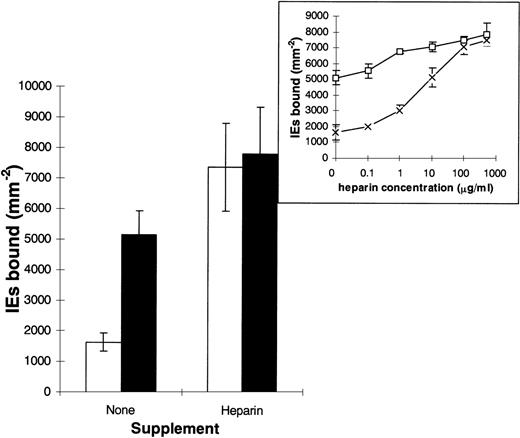



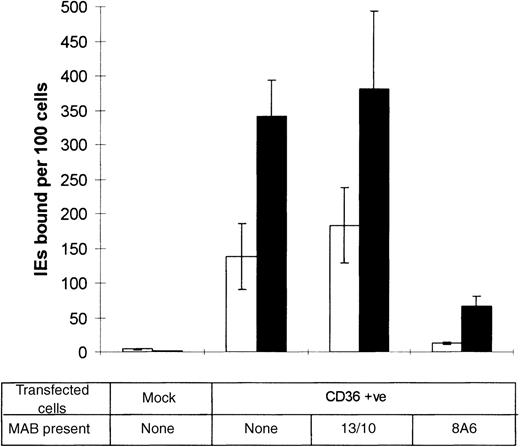
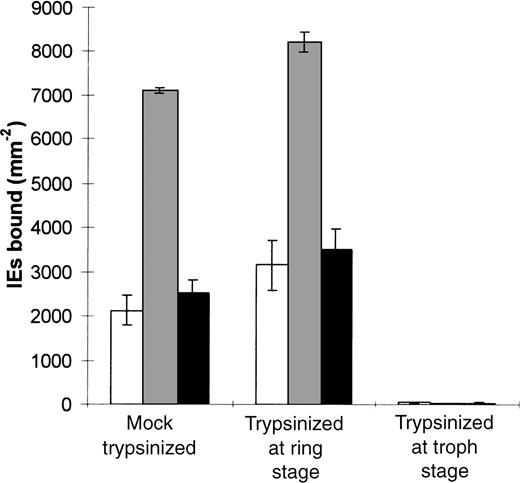

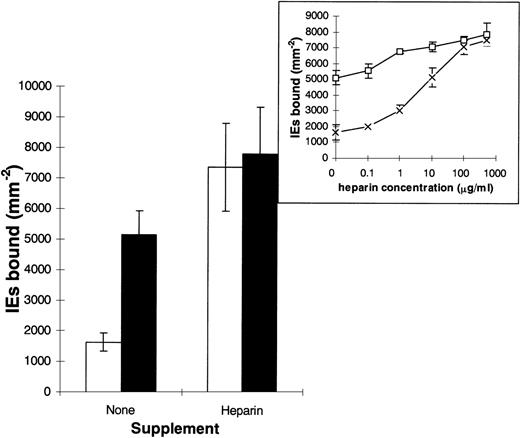
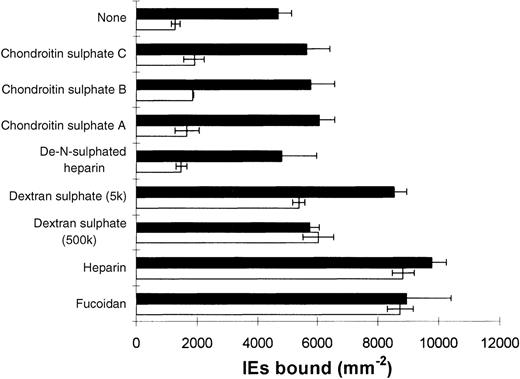
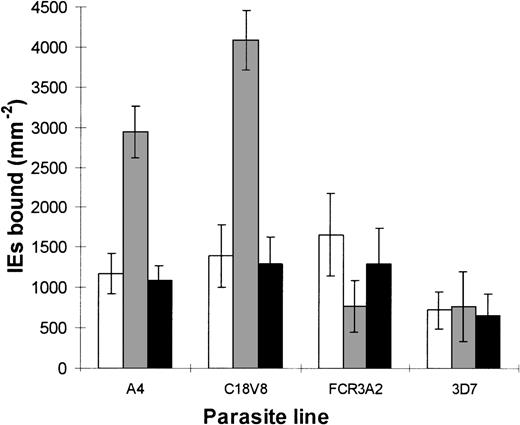
 ) or chondroitin sulfate A (▪). Results are the mean ± SEM value from 3 experiments.
) or chondroitin sulfate A (▪). Results are the mean ± SEM value from 3 experiments.